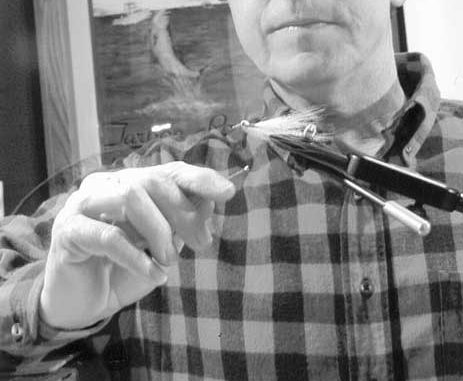
Though it’s winter, speckled trout will often be thickest in shallow water. Use this guide to help determine when you should look for fish on the flats.
Why tie flies?
That’s a frequent question I get from newbies. One reason is the same as it ever was — there’s nothing like catching a fish on a fly you tied yourself. Sounds trite, but it’s true.
Another reason is Catchmeister’s 11th Law: The fly that works best is the one you can’t buy. You can’t buy it because fly shops can’t afford to stock every fly there is. So they sell the most universally successful patterns, like Clousers, wooly buggers, poppers, etc.
What works in Texas or Florida often doesn’t work in Louisiana, and even in our state there’s variation. The best fly for reds around Dulac is the Ayo Crab, around Leeville it’s the Coma Spoon, near Myrtle Grove it’s Kirk’s Spoon, and in Cameron it’s Begnaud’s Redkiller. Only Kirk’s Spoon is commercially available.
I won’t even get into jitterbees and fluff butts, but if you find those flies in a mail-order catalog or fly shop, you’re living in a different space-time dimension than the rest of us!
So now that you have a reason to tie flies, let me say that it can be fun. But according to tying instructor Jody Titone, only if you avoid using cheap tools to do the job.
“You only need a few basic tools, so why not spend the little extra to buy quality and make your tying enjoyable?” he asks rhetorically.
Titone has taught hundreds the art of fly tying, either through his leisure classes at LSU or through seminars and workshops sponsored by clubs. He shared his thoughts on some of the essential tools.
Vise: “This holds the hook so materials can be added. Don’t skimp on a vise. A good one holds a wide range of hooks, holds them firmly in place, opens or tightens easily, and will last a lifetime. I like the Regal vise; it’s strong enough to use for deer hair work, but can also handle tiny midge patterns.”
Titone explains that vises come either as a clamp (table) or a portable base mount. He prefers the base mount for flexibility. The Regal, which sells for about $120, is a “rotary” vise in that you can turn the head 360 degrees to inspect all sides of the fly. The new Orvis and the Griffin Odyssey offer rotary features at under $80. Stationary vises such as the Griffin 2A sell for even less, about $50.
“Take this test: Put a size 2 hook in the jaws of a vise and tighten. Then push down on the shank of the hook. If the hook bends, it’s a good vise. If it slips, then look for another,” he suggested.
Scissors: “Good scissors are critical. I like pointed serrated ones because they can reach in tight spots, and the serrated edges cut materials evenly.”
Bobbin: “This tool holds the thread and allows for securing materials to the hook in a controlled manner. Always buy ceramic-tip bobbins! The ceramic edge protects thread from breaking.”
Whip finisher: “A whip finish is the most secure knot to tie off thread. This tool does it in a jiff.”
Other tools he recommends are the bodkin, hackle pliers and regular pliers. The bodkin looks like a small ice pick, and is used to apply liquid cement to thread wraps or to pick out dubbing to give flies a buggy look.
Hackle pliers allow the tier to wrap a feather around the hook, giving the appearance of legs, wings or flared gills. Regular pliers are used to bend down barbs, to bend hooks to place beads on beadhead flies or to bend the shank for keel-effect flies like the bendback.
Titone offers these other tips on tying: (1) work in a comfortable, bright location; (2) strive for quality not quantity; (3) don’t crowd the hook eye; (4) don’t be afraid to tear up and start over; and (5) always ask for help.
Seventy percent of the flies that work best in Louisiana can be tied with just a few materials. Our fish like flies with marabou, bucktail, chenille, sillilegs and mylar. They also like any color as long as it’s black, chartreuse, olive, pink or white. Most can be tied on these hooks: for salt water, Mustad 34007 size 2 or 34011 size 1, and for fresh water, Mustad 9672 sizes 6 and 10 and Eagle Claw 80 sizes 8 or 10.
Fly tying is not something you want to learn by yourself, although it’s possible. Tying classes are taught through fly shops, through college leisure courses and by fly-fishing clubs. There’s usually a fee involved for shops and the college non-credit courses, typically $40 to $60. They’re better for jump-starting your skills to a more intermediate level. On the other hand, you’ll learn light years more over time being in a club.
Learning the basics of tying without an instructor requires a good book or video. Titone’s recommendations are the introductory books by Skip Morris and the “Tying Trout Flies” video by Gary Borger. Despite it’s title, the Borger video covers in detail the foundations necessary for tying just about any fly. There are other good videos, as well as CDs and DVDs.


